I’ve often considered myself a bit of a thread hog. I tend to hog threads. I like threads! And I have a lot of them! But I’m not really calling myself names here, nor am I calling anyone else a name. Instead, I’m referring to a stitch – the plaited braid stitch – which, as mentioned the other day, eats thread like a whale eats plankton.
To show you just how much of a Thread Hog plaited braid stitch is, I’ve done some calculating for you. And when I do calculating, it’s a Big Deal, because I am not, by nature, a calculator.
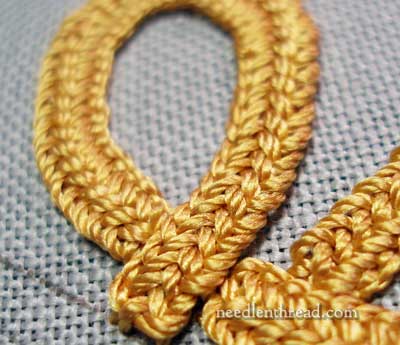
So, I set out to test plaited braid stitch using Trebizond silk, on a simple interlocking knot pattern.
The pattern is approximately 2.5″ x 2.5″ from tip to tip, horizontally and vertically. The parallel lines of the pattern are between 1/8 – 1/4″ wide (about 3/16″). The finished line ends up a bit wider than that, because the braid fills over the lines slightly, so the finished braid is about 1/4″ wide.
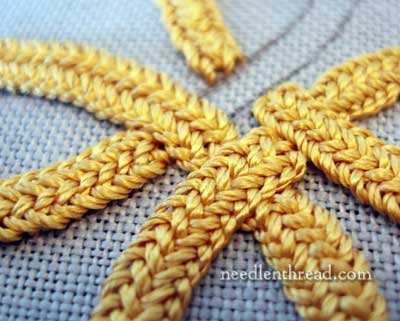
The interlocking paths don’t actually cross over each other, though they look like they do. They just sort of butt up next to each other.
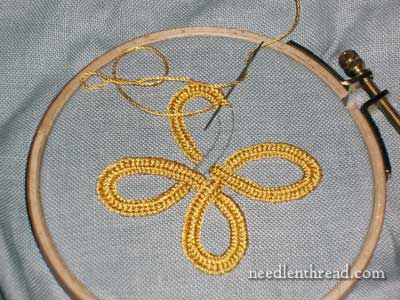
Here’s where I’m approaching the finish – not too much left to go there – around an inch of the path left to fill…
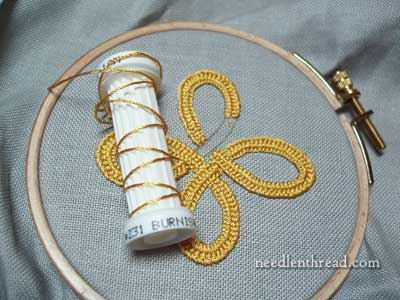
Oops – only 3/4″ left to go to finish the whole knot! Unfortunately, this is what my spool of Trebizond looked like at this point. I didn’t start with a full spool, but I started with a good amount of thread on the spool, and I thought I had enough to work the whole knot with plaited braid.
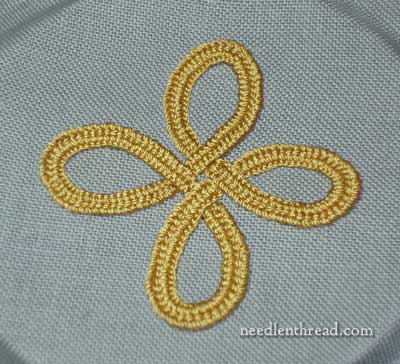
Whew. I had Just enough.
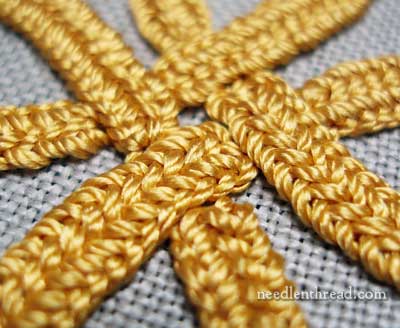
My favorite part of the knot is the intersection in the center.
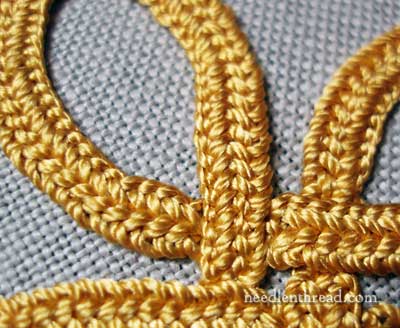
And of course, I love the smooth, thick filling created by the plaited braid and Trebizond.
The color of the Trebizond is burnished gold (#231) – it’s a lovely gold color. The background fabric is Puritan Gray by Legacy Linen, a 34-count linen in a medium soft gray. I really didn’t intend to combine these colors for any specific reason. I had the scrap of linen available, and I had this spool of Trebizond available, and so they were fated to become this sample. They’re “ok” together – they remind me of a uniform with trim – but I probably wouldn’t normally combine them. I used a tapestry needle, by the way, to work the stitch – a size 22, I believe. The tapestry needle is essential when working this stitch with the Trebizond. A needle with a sharp point would wreak havoc on the thread.
So, with the finished motif, let’s look at some figures, just to establish whether or not plaited braid stitch really is a Thread Hog.
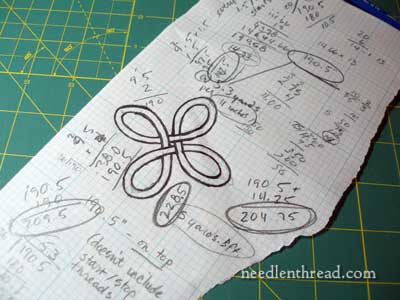
That’s how I do my figures. My grade school math teachers probably wouldn’t be too impressed. But I can read it, so that’s all that matters, right?
The design ends up being 11 inches long. If you stretched the whole knot out straight, the resulting path would be 11 inches long.
It took me approximately 205.5″ inches of Trebizond to work the knot – that’s about 17 feet, or 5+ yards of thread! There are 11 yards of Trebizond on a spool, so it took just around half the spool to work the knot.
That is One Hungry Stitch.
Keep in mind, tension and spacing have a lot to do with the amount of thread used. Also, if your thread is thicker, you might not use as much. If it is finer, you might use more.
Now, the question is, fiddling with other braid-type stitches, how do other stitches compare to this one, when it comes to thread eating? I may have to explore that question!
Any questions, comments, suggestions, wonderings, musings, inspirations you’d like to share on this topic? Feel free to leave a comment below!
Plaited Braid Stitch Printable Instructions & Exercises
If you’d like to learn the plaited braid stitch and you prefer printed instructions along with a few exercises, you may find my very affordable Plaited Braid Stitch Printable, here, quite handy! It’s only $5. It takes you step-by-step through the plaited stitch stitch, offers plenty of tips and a few exercises to help you master the stitch!







You might want to do calculations like that on your stitch instuction pages, then people can make better judgements when ordering thread for projects. 🙂
I know that the reason I hate kits and other peoples project sheets (etc) because they do indicate how much floss/thread you need, but it has been my experience (before I quit doing kits etc about 15 years ago) that often (I never finished a project that came with enough floss in it, every one I had to go and buy more of at least one) there are miscalculations and there is not enough of one color or another, and I had to search all and sundry to find the right brand/color and (in many cases) dye lot to complete the project. If you identify the hungrier stitches on your page about them, then your readers will know to order a bit more of it for thier project. 🙂 Just an idea.
I commend you for breaking out the math skills and figuring that out!
You’re ammazing. You have single-handedly inspired me to take up an art form I had never thought I would enjoy. Now I’m addicted. I’m sending the thearpy bill to you!!!
Wow. It always amazes me how much thread embroidery eats up. The same for yarn in knitting and crochet too. I guess most of us don’t really stop to think how much of the work goes side to side and backwards too.
Dear Mary,
I love the piece you did. Do you plan to “add” anything to it? I could think of several colors to use with it. But, what filling or outlining stitches would you use?
So, is this how new patterns develop or are enhanced?
hai hello wat stich have u followd
It is a beautiful stitch with Trebizond. I believe this stitch was used to imitate actual gold braid of the rich. So if you want the look, it wouldn’t matter how much thread…as long as one is aware that it will take a lot. Just make sure you have lots.
Hi Mary,
my comment is about your opening remark – I am also a Thread Hog, and have just bought some threads from Patricia Wood at Mulberry Silks. If you haven’t already seen her website, I’m sure you’ll love it – soooooo tempting! Such luscious colours and combinations!
Here’s the link: http://mulberrysilks-patriciawood.com/store/
Thanks as always for your daily email and your marvellous site!
Silkily, Judith
I love the braided stitch and it is so pretty in the Trebizond. If I were to work that stitch in gold metal what would I use? Passing thread?
What is your favorite passing thread size and type?
Looking at that just makes my heart sing!!!!
It is so beautiful and perfect (to the imperfect eye) and precise and oh……it just makes my heart sing!
Lynn
We are kindred spirits. Your calculations look like mine. It truly is a big thing to calculate your yardage, too see if working a stitch over a large area is worth it. Sometimes I find that the more expensive a thread is that the cost does weigh in on design.
I thought you were referring to me Mary. I too love thread and tend to Hog it. I get stimulated by the colours of the threads. Larraine Leonard
Good morning Mary ~ I am not familiar with Trebizond silk ( I soon will be..) what would be an equivalent in, say cotton…. Or is there… I would prefer to learn this beautiful braid stitch in something less expensive. Thank you so much for your daily inspiration. Sharon
You can definitely practice with a #5 perle cotton, Sharon. It doesn’t behave quite the same way (and doesn’t look nearly as nice, sheen wise), but it is approximately the same size, and is a good way to get familiar with the working of the stitch.
😀 “Like the whale eats plankton”… 😀
Another interesting observation, Mary! 🙂 Embroidery is such a versatile occupation, sometimes even maths needs to be involved (which I don’t like much either, but it’s all for good).
You really gotta be careful with these “thread hogs”…
Love the stitch and would consider using this in design work irregardless of the amount of thread it takes. Nice to know how much is needed though. Very pretty and celtic looking.
Your project is just stunning. I am Jewish and would love to make a Large Star of David using this stitch. However, I am a beginner…and can tell this is way above my ability. I have jotted down the name of the stitch to try once I have moved along a bit with my embroidery skills. I enjoy your posts very much. 😀
I love this stitch in the gold and think it would look lovely in silver on a dark blue jacket. What is/are your favorite sources for exploring new stitches?
I have been away for a while for various reasons, but have finally had a chance to catch up on your postings, and once again, your beautiful stitching astounds me. What a gorgeous knot! Well worth the amount of thread it “eats” up!
TRIVIA: I always thought it was interesting that when stitching a cross-stitch project, how many times I had only a few stitches to go when I neared the end of my thread — regardless of how long that thread was to begin with! Then, I learned, this happens a lot to stitchers everywhere, and thus, the “petite” (shorter) needles were invented so a stitcher could re-thread onto the petite and complete those last few stitches!
I love the Celtic knot, and I have #5 perle cottons. So I’m going to give it a whirl!
Thanks, Mary!
You are amazing!,,
how do you do this stitch? I could not find it on your website. am I missing it?
Bonjour, j’aime beaucoup ce point, qui doit avoir un autre nom, car je ne trouve aucune explications sur le web, pourriez vous m’en dire un peu plus.
Je pourrais faire de jolis ouvrages aussi.
Merci à l’avance, et pour votre partage.
A bientôt
VIANETTE.
Bonjour, Vianette –
Ceci est un ancien point peu (ou même pas) connu en France, qui date du 16eme siècle en Angleterre. Le nom de ce point est “plaited braid stitch”.
Pour répondre à votre question, pour de plus amples informations sur ce point, Mary dit qu’elle est en train de préparer un vidéo dans sa “Stitch Library” qui sera disponible en à peu près une semaine.
-Sharon in France
Hi Mary
Love your calculations! Reminds me of mine – paper and pencil, never a calculator. Shows old school training:)
That is beautiful!!!!
I think this proves that you are more calculating than I had imagined.
I also think this would a suitable stitch, done in variegated green thread to stitch an illustration of Eric Carle’s Very Hungry Caterpillar!
que puntada tan bonita. podria decirme donde encuentro el paso a paso para aprender hacer esta puntada trenza tan bonita.mil gracias.sorany
Hola,
Pude encontrar algunos videos en Youtube sobre esta puntada. Busca “plaited braid stitch” y los va a ver. Los instrucciones son ingleses, pero puede ver los pasos por lo menos. Tambien Mary va a hacer un video sobre esta puntada esta semana.
Mary, you do such beautiful stitching. Even the most simplest of designs looks nice.!
Dear Madam, Plaited braid stitch looks great. Is this thread Trebizond available in India?
Regards,
Meena
That’s a very fine sample, Mary. I’m impressed with how good it looks worked in the thick silk twist. And well done for calculating the yardage. Yes, Plaited Braid is a thread hog, but look how little of that length of thread is ‘wasted’ on the back. Just a row of small straight stitches, not too closely spaced, support that grand display of interlacing strands on the front of the stitch. No wonder plaited braid was so often used for precious metal threads.
Hi Mary,
I do not mind if its a thread hog or not. THIS IS ABSOLUTE STUNNING!! Well done.
I am also a thread freak. Wish I could choose thread for every project in coming years. haha
I just take every opportunity to dive into my thread stash.
Enjoy !!!
just looking at the photo with the nearly empty spool makes me feel in my stomach the stress of will i make it or wont i !!
This is beautiful. Is there any chance you could share the name of the stitch and some details on how to do it?
Hi, Ruth – It’s plaited braid stitch (mentioned in the second paragraph). I’ll have a video up within about a week, along with some other instructions available. ~MC
Dear Mary
This is just beautiful, I can’t wait for the how to video when!!!!!!!!!!! I am definitely going to order Trebizond for my existing Agnes Dei project for outside braiding I think it will look good. I will send you photos when I’ve finished it.
Regards Anita Simmance
please.. i would loveeeee to learn this stitch as well… <3
and i also want to show you my embroidered shirts.. which i had made on EID :))
Can i ?
Que trabajo tan maravilloso,pero no lo entiendo, quiero realizarlo,pero no entiendo como se va haciendo los dos lados iguales,GRACIAS.
The plaited braid stitch was used abundantly in scrolling blackwork so it’s quite ancient, going back to the early 1500s in Elizabethan England. This is how I came to see it for the first time & fell in love with it a first sight. But I looked far and wide for a tutorial, and yours, Mary, is definitely the best tutorial on this fascinating stitch.
It looks best in meandering lines and loops which give it a 3-dimensional relief.
Now my Celtic Knotwork projects which were on hold for lack of a “ribbon” to form the knots with, will at last be realized.
The Trebizond thread is named after an ancient city on the South-East coast of the Black Sea in former Byzantine Empire and in today’s Turkey.
Hello Mary, I love this stitch and think it would be beautiful to use on a Celtic monogram except I can’t figure out how to fill in the large rounded parts of the letter. Example the L. Do you have any pearls of wisdom to share? Thanks, Lora
Hi, Lora – I’m not sure I understand the question. Do you mean how to work the stitch on the rounded parts of the letters, or do you mean, design-wise, how to work a Celtic knot design aound the rounded parts of the letter? If the former, you might find this printable on plaited braid stitch useful: http://shop.needlenthread.com/product/plaited-braid-stitch-printable. If the latter, there are a few good books out there on developing Celtic designs. I especially like “Designing Celtic Ornament” – here’s my review for it: https://needlenthread.wpengine.com/2013/03/designing-celtic-ornament.html
Hope that helps a bit!
Your results are beautiful, and the color is rich. This stitch completely eludes me, and I’m all thumbs. Yours lay perfectly with the correct tension. Thanks for the inspiration.
Very beautiful.want to try it out .I am from India,kindly advice me which thread I should use.shall I take Anchor skies 6 strand whole
Beautiful!! Maybe someday when I retire from being retired I’ll try embroidery again. You’ve been an inspiration!!